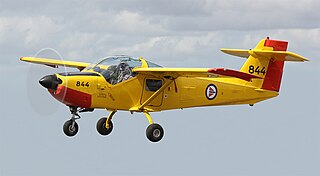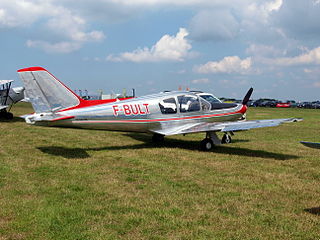The Klemm Leichtflugzeugbau GmbH was a German aircraft manufacturer noteworthy for sports and touring planes of the 1930s.

The Gulfstream American GA-7 Cougar is an American all-metal, 4-seat, twin-engined light aircraft. The Cougar was a twin-engine development of the Gulfstream American AA-5B Tiger and traces its lineage to the AA-1 Yankee Clipper and the Bede BD-1.

The Piper J-5 Cub Cruiser was a larger, more powerful version of the basic Piper J-3 Cub. It was designed just two years after the J-3 Cub, and differed by having a wider fuselage with the pilot sitting in the front seat and two passengers sitting in the rear seat. Equipped with a 75-hp Continental engine the plane's cruising speed was 75 mph. Though officially a three-seater, it would be more accurately described as a "two-and-a-half-seater", as two adults would find themselves quite cramped in the wider rear seat. The Cruiser sold for $1,798 when it was first designed.

Saab MFI-15 Safari, also known as the Saab MFI-17 Supporter, is a propeller-powered basic trainer aircraft used by several air forces.

The Klemm Kl 35 is a German sporting and training aeroplane developed as a successor to the Kl 25. A product of Klemm Leichtflugzeugbau Gmbh it shared the same single-engine, cantilever low-wing configuration as the earlier machine, the major difference being the introduction of an inverted gull wing.

The Malmö Flygindustri MFI-9 Junior was a light aircraft produced in Sweden in the 1960s. The aircraft was also produced under licence as the Bölkow Bo 208.

The Partenavia P.64B/P.66B Oscar is an Italian two/four-seat, single-engined, high-wing monoplane built by Partenavia.

The Comper C.L.A.7 Swift is a British 1930s single-seat sporting aircraft produced by Comper Aircraft Company Ltd of Hooton Park, Cheshire.

The Bölkow Bo 103 was an ultralight experimental helicopter flown in West Germany in 1961. It was designed for reconnaissance and command-control purposes and constructed by Bölkow Entwicklungen KG as part of a research order by the German Federal Ministry of Defense.

The Bölkow Bo 207 was a four-seat light aircraft built in West Germany in the early 1960s, a development of the Klemm Kl 107 built during World War II.

The MBB Bo 209 Monsun is a two-seat light aircraft that was developed in West Germany in the late 1960s.

The Robin HR100 is a French four-seat light monoplane, designed by Chris Heintz and built by Avions Pierre Robin as metal-winged version of the Robin DR253 Regent.

The Piel CP-30 Emeraude is an aircraft designed in France in the mid-1950s and widely built both by factories and homebuilders.

The Procaer F.15 Picchio is an Italian-designed light utility aircraft built by Procaer.

The Wassmer WA-51 Pacific is a French four-seat cabin monoplane designed and built by Société Wassmer. Different-powered variants include the Wassmer WA-52 Europa and the Wassmer WA-54 Atlantic. It was the world's first composite material-built aircraft.

The Spencer Amphibian Air Car is an American light amphibious aircraft. The name was first used in 1940 for a prototype air vehicle that developed into the Republic Seabee. The name was later used by its designer Percival Spencer for a series of homebuilt amphibious aircraft roughly based on the Seabee design.

The SAN Jodel D.140 Mousquetaire (Musketeer) is a French five-seat light touring monoplane based on the earlier Jodel D.117 and built by Société Aéronautique Normande (SAN) at Bernay.

The Robin DR.200 is a family of French conventional landing gear single-engined light touring or training cabin monoplanes. Originally produced by Centre Est Aéronautique the company later changed its name to Avions Pierre Robin.

The Kestrel KL-1 is an American single-engined four-seat utility aircraft designed and built in the 1990s by the Kestrel Aircraft Company of Norman, Oklahoma.

The Uetz Pelikan is a Swiss four-seat cabin monoplane designed for amateur construction by Walter Uetz.





















